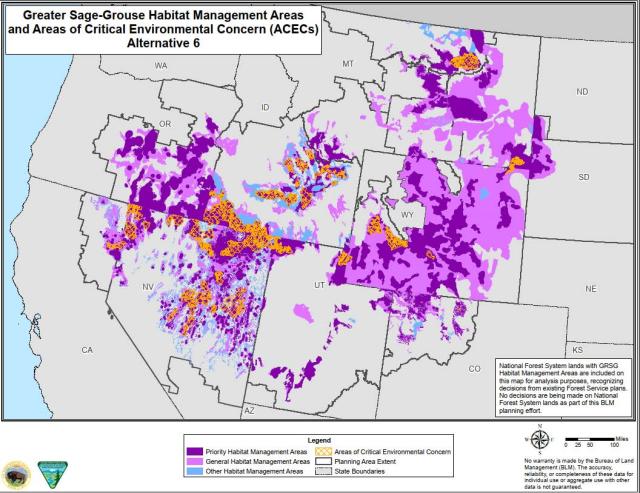You are viewing ARCHIVED content published online before January 20, 2025. Please note that this content is NOT UPDATED, and links may not work. Additionally, any previously issued diversity, equity, inclusion or gender-related guidance on this webpage should be considered rescinded. For current information, visit https://www.blm.gov/blog.
Greater sage-grouse | Proposed special management
The Federal Land Policy and Management Act (FLPMA) requires the BLM to consider designating areas of critical environmental concern (ACECs) where special management is needed to protect and prevent irreparable damage to important values, resources, systems or processes. This designation is unique to the BLM, and our planning regulations allow anyone to propose an ACEC for consideration during land use planning.
As part of planning, we evaluate a proposed ACECs to determine whether it meets the relevance and importance criteria specified in FLPMA. The environmental analysis that supports a planning decision includes special management actions for nominated areas that meet the relevance and importance criteria.
We received nominations for ACECs to protect greater sage-grouse habitat for evaluation during the current effort to update the habitat management plans adopted in 2015.
A group of non-governmental organizations nominated 48,202,418 acres of public lands during scoping for the draft environmental impact statement (EIS). Additional ACEC nominations submitted later in the process covered smaller areas that are encompassed by the earlier nomination (Appendix 5, section 5.3, p. 5-2 – 5-3).

Sagebrush Sea Reserve ACEC Nomination, p. 5-2 || BLM, 2024
Section 5.4 of Appendix 5 details our evaluation of the ACEC nominations.
Relevance
All areas where greater sage-grouse are present and all areas designated as their habitat were determined to meet the relevance criteria (p. 5-4).
Importance
Meeting importance criteria required analyzing how a particular area's habitat characteristics compare with other greater sage-grouse habitat. To have sufficient importance, a nominated area must generally must be more locally significant and have 'special worth, consequence, meaning, distinctiveness, or cause for concern (p. 5-4).
This meant that not all habitat designated as priority (PHMA) in the 2015 plans meets the importance criteria because the characteristics of some PHMA acres are only locally significant.
The draft EIS analyzes a total of 11,139,472 acres as potential ACECs under Alternative 3 and Alternative 6.
Section 5.4.5 (p. 5-48) breaks down this total number by state.

Potential ACECs in relation to Alternative 3 Habitat Management Areas, p. 5-49 | BLM, 2024.

Potential ACECs in relation to Alternative 6 Habitat Management Areas, p. 5-50 | BLM, 2024.
The fact that a particular area meets the relevance and importance criteria does not automatically mean that an ACEC is needed: the area must require special management to protect and prevent irreparable damage to the given resource values. Chapter 2, sections 2.2.3, 2.2.6 and 2.5.12 lay out the special management that would apply under the two alternatives that would designate ACECs.
Special Management
- Alternative 3 would allow the same uses in ACECs as in areas designated Priority Habitat Management Areas (PHMAs) – see Figure 5-3, above.
- Management of ACECs would be less restrictive under Alternative 6 (Figure 5-4, above) compared with Alternative 3 but nonetheless more so than what would be allowed in the non-ACEC priority habitat.
In the draft EIS, Alternative 5 is the preferred alternative. It differs from Alternative 6 only in that it would not designate any ACECs.
The final EIS may revise or combine the draft alternatives, and the final selected alternative will be adjusted in response to comments received during the comment period and further coordination with state, local and Tribal partners.
GET INVOLVED | Review and comment on the draft environmental analysis of proposed options for protecting the greater sage-grouse's habitat on BLM-managed public lands. The public comment period is open through June 13, 2024.*
Commenting on the draft alternatives and draft impact analysis is not limited to voting for one alternative or another.
The most useful comments present new information relevant to the draft EIS, question with a reasonable basis the information or methodology in the draft EIS or propose a reasonable alternative other than those analyzed in the draft EIS.
* Note | The typical comment period on proposed ACECs is 60 days, but in the context of planning for managing greater sage-grouse habitat on BLM-managed lands, we will consider all substantive comments on ACECs received during the 90-day comment period on the draft EIS.
Heather Feeney, Public Affairs Specialist
Related Stories
- Using science to uncover mysteries of the Mesa archaeological site in Alaska
- “Where did my horse come from?” BLM launches a new way for adopters, trainers and others to learn about their wild horses and burros
- Lake Havasu Fisheries Improvement Program is the gift that keeps giving
- BLM is thankful for public lands volunteers
- BLM delivers on administration priorities
